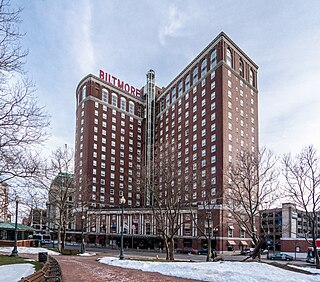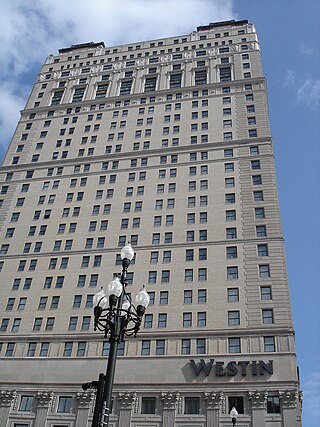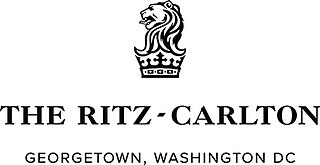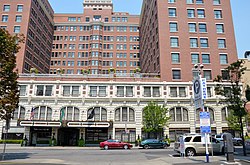
The Mayflower Hotel is a historic hotel in downtown Washington, D.C., located on Connecticut Avenue NW. It is two blocks north of Farragut Square and one block north of the Farragut North Metro station. The hotel is managed by Autograph Collection Hotels, a division of Marriott International.

The Graduate Providence is an upscale hotel that opened in 1922 as the Providence Biltmore Hotel, part of the Bowman-Biltmore Hotels chain. It is located on the southern corner of Kennedy Plaza at 11 Dorrance Street in downtown Providence, Rhode Island. It was added to the National Register of Historic Places in 1977 and is a member of Historic Hotels of America, the official program of the National Trust for Historic Preservation.

KQNT is a commercial radio station licensed to Spokane, Washington. It is one of the oldest radio stations in Washington, going on the air in 1922 in Seattle. KQNT offers a news/talk format and is owned by iHeartMedia, Inc. The studios and offices are on East Sprague Street in Spokane.
Kirtland Cutter was a 20th-century architect in the Pacific Northwest and California. He was born in East Rockport, Ohio, the great-grandson of Jared Potter Kirtland. He studied painting and illustration at the Art Students League of New York. At the age of 26 he moved to Spokane, Washington, and began working as a banker for his uncle. By the 1920s, Cutter had designed several hundred buildings that established Spokane as a place rivaling Seattle and Portland, Oregon in its architectural quality. Most of Cutter's work is listed in State and National Registers of Historic Places.
Llewellyn Marks "Louis" Davenport was an American businessman best known for establishing the Davenport Hotel in downtown Spokane, Washington.

The Driskill, a Romanesque-style building completed in 1886, is the oldest operating hotel in Austin, Texas, United States, and one of the best-known hotels in Texas generally. The Driskill was conceived and built by Col. Jesse Driskill, a cattleman who spent his fortune constructing "the finest hotel south of St. Louis".

The Lake McDonald Lodge is a historic lodge located within Glacier National Park, on the southeast shore of Lake McDonald. The lodge is a 3+1⁄2-story structure built in 1913 based on Kirtland Cutter's design. The foundation and first floor walls are built of stone, with a wood-frame superstructure. The lobby is a large, open space that extends to the third story. It has a massive fireplace and a concrete floor scored in a flagstone pattern, with messages in several Indian languages inscribed into it. The rustic lodge was designated a National Historic Landmark in 1987 as one of the nation's finest examples of large-scale Swiss chalet architecture. Lake McDonald Lodge is a member of Historic Hotels of America, the official program of the National Trust for Historic Preservation.

The Westin Book Cadillac Detroit is an historic skyscraper hotel in downtown Detroit, Michigan, within the Washington Boulevard Historic District. Designed in the Neo-Renaissance style, and opened as the Book-Cadillac Hotel in 1924, the 349 ft (106 m), 31-story, 453-room hotel includes 65 exclusive luxury condominiums and penthouses on the top eight floors. It reopened in October 2008, managed by Westin Hotels, after a $200-million restoration.

The Roosevelt New Orleans in New Orleans, Louisiana, is a 504-room hotel owned by AVR Realty Company and Dimension Development and managed by Waldorf Astoria Hotels & Resorts. The hotel was originally built by Louis Grunewald, a German immigrant, and opened in 1893 as "The Hotel Grunewald."

The DoubleTree Suites by Hilton Hotel Detroit Downtown - Fort Shelby is a restored historic high-rise hotel, located at 525 West Lafayette Boulevard in Downtown Detroit, Michigan.

Downtown Spokane or Riverside is the central business district of Spokane, Washington. The Riverside neighborhood is roughly bounded by I-90 to the south, Division Street to the east, Monroe Street to the west and Boone Avenue to the north. The topography of Downtown Spokane is mostly flat except for areas downstream of the Spokane Falls which are located in a canyon; the elevation is approximately 1,900 feet (580 m) above sea level.

Spokane Convention Center is the primary convention center in Spokane, Washington, in the northwest United States, and consists of two interconnected buildings along the south bank of the Spokane River in downtown Spokane. The facility, owned and operated by the Spokane Public Facilities District, is part of a larger campus, historically referred to as Spokane Center, that also contains the adjacent First Interstate Center for the Arts which is connected to the Davenport Grand hotel across the street via a skywalk.

The Battle House Renaissance Mobile Hotel & Spa, is a historic hotel in Mobile, Alabama. The current structure was built in 1908 as the Battle House Hotel. It is the second hotel by that name to stand in this location, replacing an earlier Battle House built in 1852, which burned down in 1905. It is one of the earliest steel frame structures in Alabama.

The Hotel Blackhawk is an eleven-story brick and terra cotta building located in Downtown Davenport, Iowa, United States. It is a Marriott Autograph Collection property.

The Seelbach Hilton Louisville is a historic hotel in Louisville, Kentucky, United States. Founded by Bavarian-born immigrant brothers Louis and Otto Seelbach, it opened in 1905 as the Seelbach Hotel, and is designed in the French Renaissance style. The hotel has hosted numerous celebrities, including F. Scott Fitzgerald, who took inspiration from the Seelbach for a hotel in The Great Gatsby. The hotel is part of the Hilton Hotels & Resorts chain.

The Ritz-Carlton Georgetown, Washington, D.C., is a luxury hotel located in the Georgetown neighborhood of Washington, D.C. It is near The Kennedy Center and the Georgetown waterfront. It is an AAA 5-star luxury hotel, and has 86 rooms, 27 premier suites, and five luxury suites. All rooms and suites have a view of the Potomac River and historic Georgetown. It contains a 140 feet (43 m) smokestack coming from the lobby fireplace. It is a small hotel and is known to be good for privacy. The hotel contains a restaurant, bar, and a fitness center with a newly refreshed spa after a $1.5 million renovation in 2016. The rooms are on average 450 square feet (42 m2) in size and is located in a historic industrial building.

The Newbury Boston is a historic luxury hotel in Boston, Massachusetts. It opened in 1927 as The Ritz-Carlton Hotel. The property is a Boston landmark and anchors fashionable Newbury Street and the picturesque Boston Public Garden, located in the heart of the Back Bay.

The Hamilton Hotel is a AAA 4-diamond hotel in downtown Washington, D.C., United States, located at 1001 14th Street, N.W., just to the north of Franklin Square. It is a member of Historic Hotels of America, the official program of the National Trust for Historic Preservation.

The Fairmont Washington, D.C. Georgetown is a luxury Postmodernist-style hotel located at 2401 M Street NW in Washington, D.C., in the United States. The structure, in the West End neighborhood of the city, opened in December 1985 as The Westin Hotel. In December 1989, Westin sold the hotel to All Nippon Airways, which operated it as the ANA Hotel. Lowe Enterprises purchased the hotel in October 1998, and renamed it the Washington Monarch Hotel. A $12 million renovation followed in 1999. Lowe Enterprises sold the hotel to Legacy Hotels Real Estate Investment Trust in October 2002, and Legacy contracted with Fairmont Hotels and Resorts to manage the hotel. The hotel was renamed The Fairmont Washington, D.C. Legacy was itself purchased by Cadbridge Investors in July 2007 and the hotel sold to MetLife in 2014, although the property remained branded a Fairmont. A $27 million renovation was completed in January 2017.

The Davenport Hotel Collection is a brand collection of four upscale hotels in Spokane, Washington. All the hotels are located in Downtown Spokane. The brand is owned by KSL Capital Partners and operated by the Davidson Hospitality Group.




































